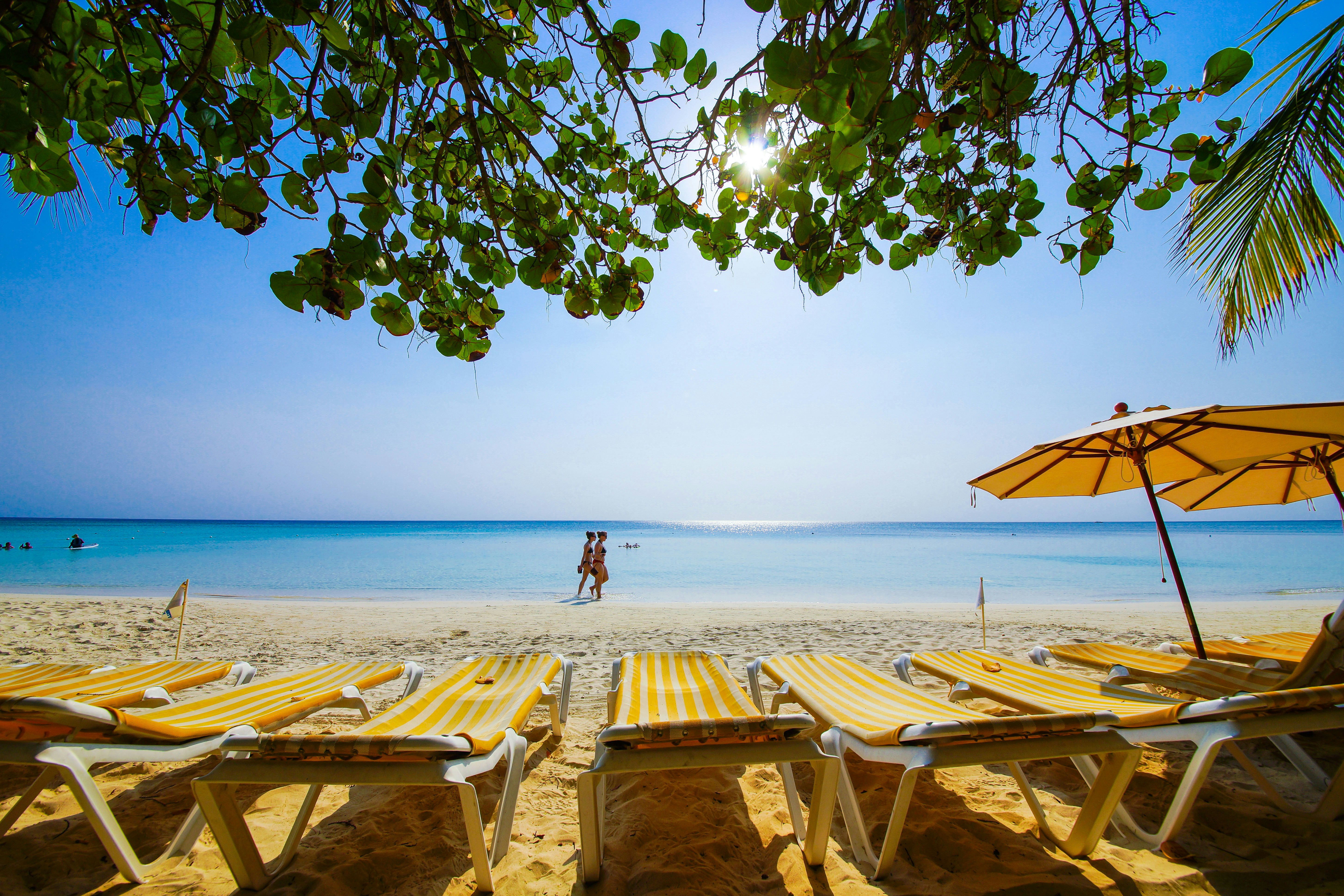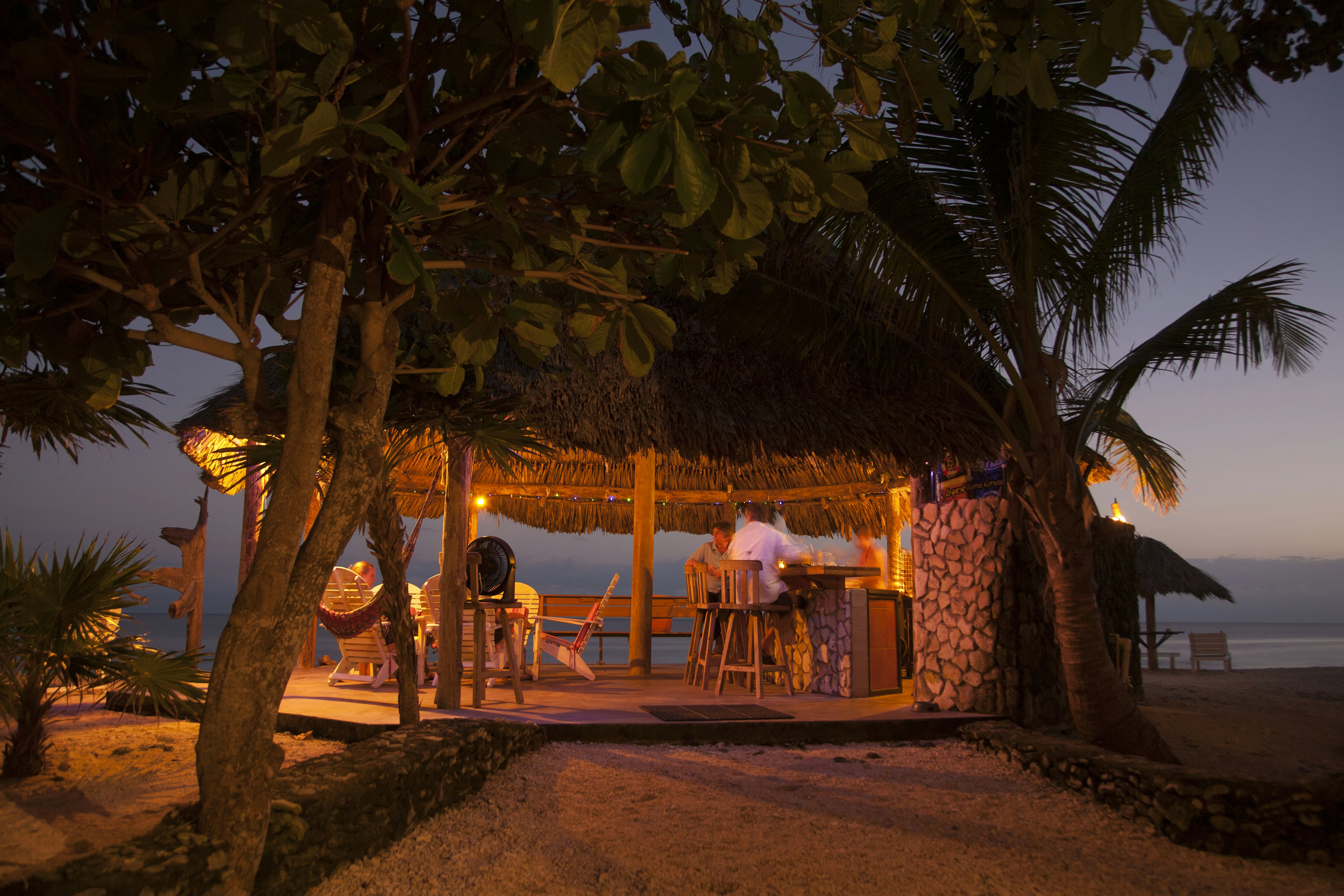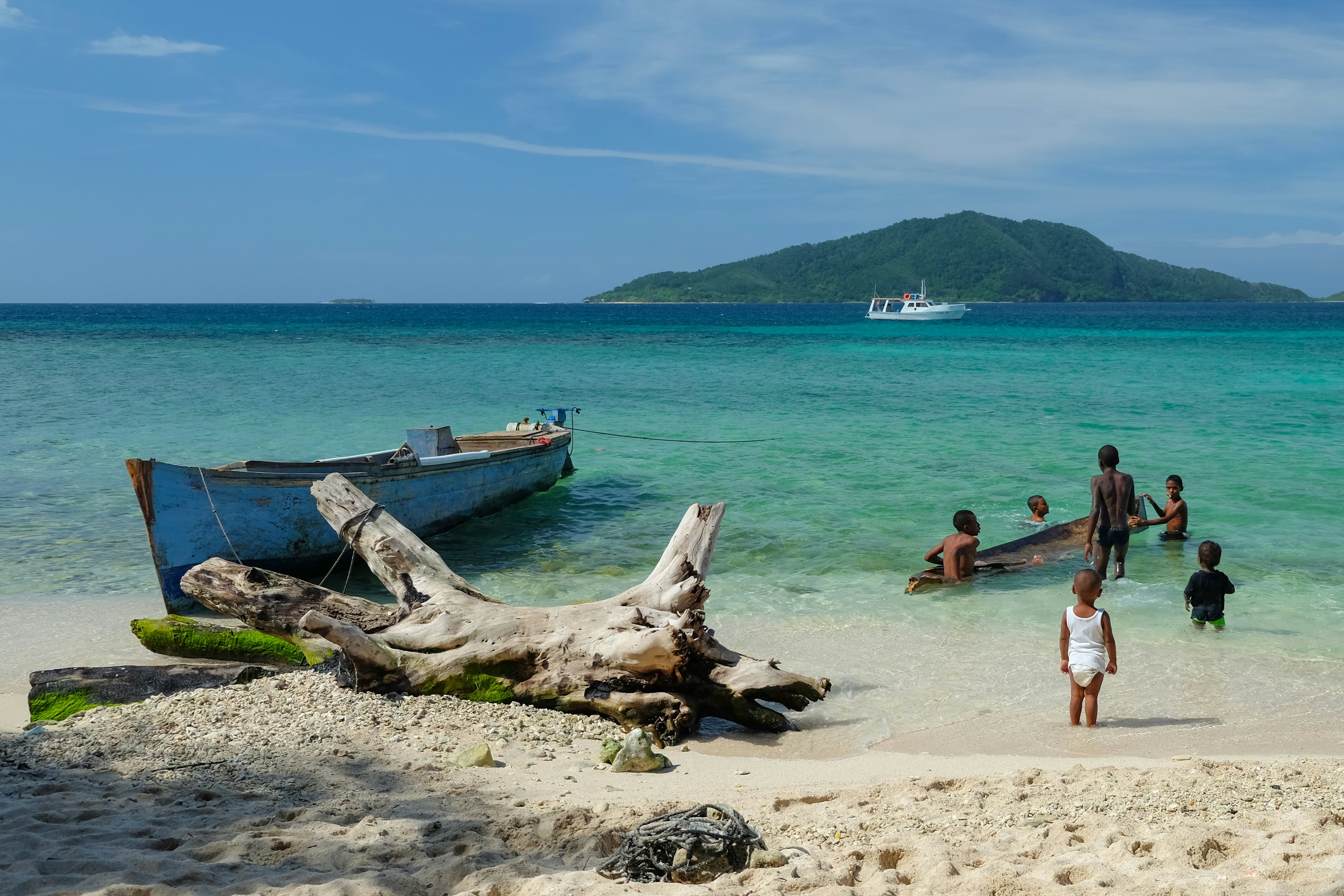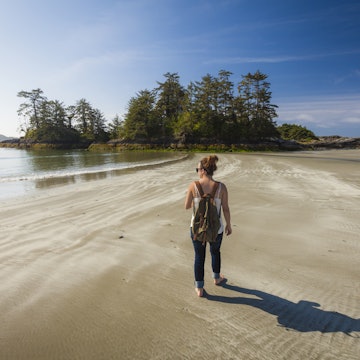
The best beaches in Honduras, from the Caribbean Coast to the islands

Jul 17, 2022 • 13 min read

From the Caribbean coast to the offshore isles, the beaches of Honduras are a slice of tropical heaven © Antonio Busiello / Getty Images
Travelers flock to Central America for its beaches, and Honduras, spanning the isthmus from the Caribbean Sea to the Pacific Ocean, has some of the best, spread along over 800km (500miles) of coastline.
The beaches on Roatán are one of the country’s biggest draws, and the island is a world-renowned scuba diving destination and major port-of-call for cruise ships. But if you’ve got time to beach-hop across the entire country, from the Bay Islands to the mainland, you may have the whole shore to yourself, free from shiploads of cruise ship passengers.
From the Caribbean Coast to the islands, here's our pick of the best beaches in Honduras.
Half Moon Bay Beach, Western Roatán
Best beach for nightlife
While they might have similar names, don’t confuse famous West Bay with West End, the beachy area on the north coast of Roatán. These two beach hubs are connected by taxis, water taxis or a 40-minute walk along the coast. Heading north from the resorts of West Bay, West End is the first hub of tourism you'll reach, with an appealing little beach of its own, Half Moon Bay Beach, which runs for just 400m (1312ft).
You’ll notice a blue flag waving in the wind amongst the palm trees with the words “Bandera Azul Ecológica” on it. This means this beach is Blue Flag certified and has met the standards determined by this global non-profit organization in areas of safety, accessibility, education and above all, environmental protection. The beach's water quality is tested regularly to maintain its Blue Flag status, and despite its proximity to the island’s busiest nightlife, the water here remains pristine.
Close by, West End’s Main Street is a lively hub of restaurants and bars catering to locals, backpackers and expats, including notable staples such as Sundowners, known for live music, Happy Harry’s Hideaway on the end of a pier, and Booty Bar, whose name is sometimes spelled “Barrrr” to go with its pirate theme. It's the crowd who frequent these places, joined by local families, that set the scene along Half Moon Bay.

West Bay Beach, Western Roatán
Best beach when time is limited
If your time is limited and you are on a mission to find an easy, clean beach to relax on with a book and a cocktail, then this 950m (3116ft) stretch of sand on the north coast of Roatán couldn't be more convenient.
West Bay Beach is lined with beachfront resorts, making it super easy to step outside a hotel, kick off your flip-flops, and be barefoot in its white sands right away. When you want to get more active, fit in an off-shore snorkel session or scuba dive with a local operator such as West Bay Divers.
Since the Bay Islands were under British rule before returning to Honduras in 1859, the majority of islanders speak good English. However, along with this convenience, there are a few caveats. As this is the most popular beach for tourists coming to Roatán via cruise ship or direct international flights, solitude is rarely an option.
There are also many beachside restaurants, with most of the menus catering to, not surprisingly, the Western palate – which may be welcome news if you’re a picky eater. You’re bound to find something to enjoy with lots of local seafood options such as fish tacos or coconut shrimp at The Thirsty Turtle.
For something more elevated, Luna Muna, the restaurant of the fancy Ibagari Boutique Hotel, caters to a more refined palate, serving up octopus ceviche and conch carpaccio.
As West Bay is a hub for many of the American and Canadian expats living on Roatán, it’s also not hard to find pizza, hamburgers or even proper Canadian poutine at the Hangover Hut, run by an expat couple from Toronto.

Camp Bay Beach, Eastern Roatán
Best beach for undeveloped beauty
If you ask local Roatánians what their favorite beach is, you’ll always get the same answer – Camp Bay. L
ocated in the municipality of Santos Guardiola, which comprises the eastern half of Roatán island, this Blue Flag beach is a popular barbecue spot for locals, and its undeveloped, pristine white sands, flanked by natural coconut trees, are a step back in time. Islanders say it’s what West Bay was like 25 years ago, before the rapid rise of the resorts.
You can get to Camp Bay by taking the road that spans the length of the island; the beach is near the end on the north shore. No buses run here, so the cheapest option is to go by taxi. However, taxis only go from town to town, so you’ll have to take a series of inter-town taxis, progressively westbound, to reach Camp Bay; budget about L690 for a round-trip from West Bay. However, it's much easier to get there directly by hiring a private car for about L3700 or renting a vehicle, if you've got a few extra dollars.
With the lack of development at this beach, it's best to bring your own provisions. But, if you’re looking to score some food or drink nearby, walk all the way down to La Sirena de Camp Bay, a little bar and restaurant on a pier in the nearby Camp Bay village – a place where kids play in the street away from the world of mass tourism.
Chepes Beach, Utila
Best public beach
Just 49km (30miles) from Roatán, Utila is the smallest of the Bay Islands, with a totally different vibe. The island is a famous enclave of international backpackers, beachgoers and aspiring scuba divemasters, with its own collection of sandy beaches. Get there via an hour-long ferry ride on the Utila Dream from Roatán or take a 45-minute ride from La Ceiba on the mainland; both boats charge L750.
It’s fitting that flags of different nations of the world line Chepes Beach, the public beach in the middle of Utila’s one small town. Just 220m (721ft) long, Chepes Beach is quite small, but conveniently close to dive hostels, beach bars and favorite local restaurant, Coconuts. And nothing in town is really that far away since the beach is in such a centrally located area.
If you're looking for a post-beach experience and have a bigger budget, walk about eight minutes northeast and dine at Asian fusion eatery Mister Buddha or stay at the new, youthful boutique hotel Manurii.

Bando Beach, Utila
Best semi-private beach for young people
If you see locals playing tug-of-war on the beach, you’ve reached Bando Beach, a popular hangout for the local community on Utila. Once a year, islanders hold a friendly sporting competition known as the Utila Olympics at Bando, but at other times, the beach is clean and well-maintained, and it's currently the only Blue Flag beach in Utila. Bando is just a 15-minute walk away (or a short ride via scooter, bike, or ATV) from the center of Utila's main town.
Near the mangroves on the eastern point of the natural harbor on Utila’s southern shore, Bando is a favorite spot to chill under the shade of its numerous palm trees. Since it’s protected from the open sea, it’s also a great place for stand-up paddle boarding.
Although technically a private beach for guests staying at the locally-owned Sea Eye Hotel, Bando Beach is open to day visitors for L40. That’s a small fee to pay for access to fresh water showers, clean bathrooms, beach volleyball and picnic tables – amenities not found at the public beach across town.
It’s also easier to grab a cold beer or freshly mixed piña colada as there’s a bar on the premises. If you’re hungry, ask the bartender for their rendition of alambre (grilled beef with bacon, peppers, cheese and salsa) – it’s a crowd-pleaser.
Bayman Bay Beach, Guanaja
Best beach to avoid the crowds
Head to Bayman Bay on the Bay Island of Guanaja to find one of the best beaches in the country. Bayman Bay Beach is a small, secluded strip of white sand, green foliage and turquoise waters. For anyone looking to truly get off the grid, this is the spot. In fact, the whole island of Guanaja is off the radar for most travelers to Honduras.
You’d think that being the only Bay Island with a waterfall, Guanaja would be more touristy, but it’s actually the least visited of the Bay Islands, due to limited access to the islands, though this is changing.
Before, only domestic flights or expensive charter boats could get you to Guanaja, but since October 2021, the Galaxy Wave ferry has expanded its service from the mainland to Roatan with an extra stage to Guanaja, running four times a week for L855.
With some of the most pristine, undeveloped beaches across the Bay Islands, Guanaja truly represents life before mass tourism; however, the island is in recovery mode after Hurricane Mitch caused devastation in 1998, followed by a major fire in October 2021 in El Cayo, the main town.
Though there's a long road ahead for reconstruction, flight and ferry services are still running and you don’t actually need to go to the main town to visit the island’s spectacular white-sand beaches. From the main dock, it’s easy to get a water taxi to Bayman Bay or other notable beaches such as Soldado Beach or Graham’s Cay, for about L1470 for a round trip.

Cayo Chachahuate, Cayos Cochinos
Best beach for snorkeling and scuba diving
It would be remiss when highlighting beaches in the Bay Islands to not include another set of gorgeous Honduran islands – the Cayos Cochinos. While officially a part of the municipality of Roatán, the archipelago is closer to La Ceiba on the mainland. There are two main islands, Cayo Grande and Cayo Menor, plus 13 smaller coral keys.
The inhabited key of Cayo Chachahuate has a beautiful beach that most Cayos Cochinos boat tours stop at. Not only are there soft white sands to bury your bare feet in, there are also fresh lunch options for your belly.
Meals are prepared by the island’s Garífuna community – islanders of mixed Arawak and African heritage – who reside in this secluded part of the country. Most of the men are fishermen, so fish will always be the freshest option since everything else needs to be imported from the mainland.
Speaking of fish, these Cayos are some of the best places to spot them in their natural environment. Surrounded by turquoise waters, all the islands are part of a protected marine area managed by the Honduran Coral Reef Foundation, with great snorkeling and scuba diving on a section of the Mesoamerican Barrier Reef, the world's second-largest coral reef system. Here, your chances of spotting an eagle ray or a sea turtle are pretty good.
Booking a day tour by boat from Roatán is the best way to reach the Cayos Cochinos (a trip of about an hour each way) but you can also come from La Ceiba or Sambo Creek on the mainland (about half an hour). Boats tour around the different keys – or at least the ones not privately owned – visiting some that are uninhabited, with beaches that are virtually untouched until a boat lands on the shore.
Honduras road trip to Copán Ruins
Puerto Escondido, Punta Sal National Park, Tela
Best beach closest to San Pedro Sula
While Honduras’ islands get most of the praise in a round-up of the country’s best beaches, you shouldn’t miss the beaches on the mainland. If you’re flying into Honduras, chances are you’ll land in the city of San Pedro Sula, a bustling urban hub of companies and transportation. If you’re basing yourself here and want to head to the closest beach, it’s about a two-hour drive to Tela, the area's best beach town on the Caribbean coast.
Tela lies on an eponymous bay, with many white sand beaches along its turquoise shoreline, including the public beach in town and Playa La Ensenada, about 11km (6.8 miles) away by car. However, arguably the best beach experience in the area is the trip to Punta Sal National Park, aka Jeannette Kawas National Park, named after a renowned environmental activist.
Operators such as Garífuna Tours can bring you here via boat, exploring the park’s important coastal marine and tropical rainforest ecosystems. A highlight of the seven-hour excursion is the easy hike along a rainforest trail to the isolated cove of Puerto Escondido – a secluded white sand beach, surrounded by jungle, with tranquil waters that are prime for snorkeling.

Trujillo Bay Beach, Trujillo
Best mainland beach in the east
The beaches near Trujillo, a former Spanish colonial city once visited by Christopher Columbus, stand out as some of the best in the country. The white sands along the Bay of Trujillo attract locals and tourists alike, offering sun, sand and surf on the Caribbean side of the country. If you get motion sickness on boats, these beaches are your best bet, since you don’t need to take one to get here from the mainland.
Some of the area’s beaches are tied to a resort, such as lovely Santa Fe Beach at the Banana Beach Resort, but the public beach in Trujillo’s city center – not far from the colonial-era Fortaleza de Santa Bárbara – is a popular spot, especially with local families. Since it’s a city beach, there’s no need to bring provisions; there are many locally-owned shops here, plus restaurants and bars.
In place of celebrity chefs, the stars of this area are the starfish. Nearby boats can bring you out to the Banco de Estrellas (Bank of Stars), where dozens of different types of starfish congregate on the seafloor in waist-high waters. Along with Playa Estrella, one of Panama's beach beaches, this is one of just two places in Central America where complex starfish colonies thrive, due to an abundance of seagrass.
Don’t be tempted to pick them up; it disturbs these delicate creatures. Instead, just observe and snap some pictures with an underwater camera, or your camera phone if it's waterproof or has a waterproof case.
Playa del Amor, San Lorenzo
Best beach closest to Tegucigalpa
If you find yourself in Tegucigalpa, the landlocked capital city of Honduras, and are looking to get away to the closest beach, your best bet is to head to the Pacific coast. Aim for the municipality of San Lorenzo, about a two-hour drive south from the capital – the base town for exploring the black sands in and around the Gulf of Fonseca.
There are several notable beaches in the area, particularly Playa Grande and Playa Negra on the small coastal island of Amapala (aka Isla del Tigre). You can get here easily by small boat from the port town of Coyolito. However, arguably the best – and most romantic – beach around is Playa del Amor (Beach of Love) located on the coastal island of Conchaguita. The island can only be accessed by boat from the port in San Lorenzo.
Part of the allure of this mysterious beach is that the magic is fleeting – most of its black sands are only exposed when the tide is low, for four to five hours each day. Be sure to bring your own provisions to this romantic, secluded, spot in the mangroves.
Locals jokingly say it's the beach “where two people go in, but three come back” and it’s a popular destination on Valentine’s Day. When the water rises and the beach disappears, boats typically continue around the mangroves until the orange-hued sun sets on the Pacific horizon.













